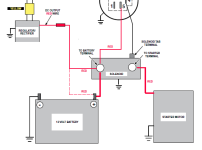Fabrikater
Forum Newbie
- Joined
- Oct 27, 2024
- Threads
- 1
- Messages
- 9
Hello everyone.
Newly joined today in the hope that there's someone out there who can help.
I have a Vanguard 16hp V-twin engine.( Model No; 303777) I bought it used. The wiring and cables were cut off by whoever removed it from whatever it was in. I believe a ride-on mower as it is the vertical crankshaft version with a twin belt pulley. So, not having any of the original loom and having no need for a keyswitch, lights, ancillary eqiuipment or safety switches, I aim aiming to wire a simple toggle power switch, with 'kill switch' tab, and pushbutton start. I've installed a single pole solenoid and cabling for battery connections.
I need to identify the severed cables left on the motor to be able to complete the wiring for starting, running and charging.
?
Cable controls do not present a problem. Electrics have never been my favorite thing
 .
.
I have attached a photo showing the cables.
The two YELLOW wires come from the recifier(?) into a connector with two matching YELLOW cables.
The cable between the above two is solid RED and continues in solid RED after the connector.
The BLACK wire to the right is from the crankcase and changes to RED with BLACK trace after connector. (I believe this is the 'kill' wire)
Apparently, one of these has a diode in it but these two connectors seen normal, as in nothing special but any comment/info would be welcome as well as confirmation that this motor is negative earth..
Well, that's what I have, any help would be much appreciated.
Ian the Fabrikater.
Newly joined today in the hope that there's someone out there who can help.
I have a Vanguard 16hp V-twin engine.( Model No; 303777) I bought it used. The wiring and cables were cut off by whoever removed it from whatever it was in. I believe a ride-on mower as it is the vertical crankshaft version with a twin belt pulley. So, not having any of the original loom and having no need for a keyswitch, lights, ancillary eqiuipment or safety switches, I aim aiming to wire a simple toggle power switch, with 'kill switch' tab, and pushbutton start. I've installed a single pole solenoid and cabling for battery connections.
I need to identify the severed cables left on the motor to be able to complete the wiring for starting, running and charging.
?
Cable controls do not present a problem. Electrics have never been my favorite thing

I have attached a photo showing the cables.
The two YELLOW wires come from the recifier(?) into a connector with two matching YELLOW cables.
The cable between the above two is solid RED and continues in solid RED after the connector.
The BLACK wire to the right is from the crankcase and changes to RED with BLACK trace after connector. (I believe this is the 'kill' wire)
Apparently, one of these has a diode in it but these two connectors seen normal, as in nothing special but any comment/info would be welcome as well as confirmation that this motor is negative earth..
Well, that's what I have, any help would be much appreciated.
Ian the Fabrikater.


